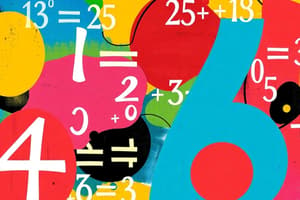Podcast
Questions and Answers
What is the result of $3^2$?
What is the result of $3^2$?
- 6
- 9 (correct)
- 12
- 8
Any number raised to the power of zero equals zero.
Any number raised to the power of zero equals zero.
False (B)
What is the process called when you simplify an expression such as $2(x + 3)$?
What is the process called when you simplify an expression such as $2(x + 3)$?
Distributing
The equation $5x + 3 = 18$ can be simplified by first subtracting ______ from both sides.
The equation $5x + 3 = 18$ can be simplified by first subtracting ______ from both sides.
Match the following exponent rules with their descriptions:
Match the following exponent rules with their descriptions:
What is the value of $x$ in the equation $3x - 4 = 5$?
What is the value of $x$ in the equation $3x - 4 = 5$?
The expression $x^{-3}$ can be simplified to $1/x^3$.
The expression $x^{-3}$ can be simplified to $1/x^3$.
What do you call the variable 'x' in the equation $2x + 5 = 11$?
What do you call the variable 'x' in the equation $2x + 5 = 11$?
The result of $x^2 * x^3$ using the product rule is $x^{______}$.
The result of $x^2 * x^3$ using the product rule is $x^{______}$.
What will be the result of $(x^2)^3$ using the power rule?
What will be the result of $(x^2)^3$ using the power rule?
Flashcards
Exponent
Exponent
A mathematical notation indicating repeated multiplication of a base number. For example, 2 raised to the power of 3 (2^3) means multiplying 2 by itself three times (2 x 2 x 2 = 8).
Base (in exponents)
Base (in exponents)
The number being multiplied in an exponent. In 2^3, the base is 2.
Exponent (in exponents)
Exponent (in exponents)
The number that indicates how many times the base is multiplied by itself. In 2^3, the exponent is 3.
Product Rule of Exponents
Product Rule of Exponents
Signup and view all the flashcards
Power Rule of Exponents
Power Rule of Exponents
Signup and view all the flashcards
Quotient Rule of Exponents
Quotient Rule of Exponents
Signup and view all the flashcards
Zero Exponent Rule
Zero Exponent Rule
Signup and view all the flashcards
Negative Exponent Rule
Negative Exponent Rule
Signup and view all the flashcards
Variable (in Algebra)
Variable (in Algebra)
Signup and view all the flashcards
Combining Like Terms
Combining Like Terms
Signup and view all the flashcards
Study Notes
Exponents
- Exponents represent repeated multiplication. For example, 23 means 2 multiplied by itself 3 times (2 x 2 x 2 = 8).
- The base is the number being multiplied. The exponent indicates how many times the base is used as a factor.
- Rules for working with exponents:
- Product rule: When multiplying terms with the same base, add the exponents. (e.g., x2 * x3 = x5)
- Power rule: When raising a power to another power, multiply the exponents. (e.g., (x2)3 = x6)
- Quotient rule: When dividing terms with the same base, subtract the exponents. (e.g., x5 / x2 = x3)
- Zero exponent rule: Any non-zero number raised to the power of zero is equal to one. (e.g., 50 = 1)
- Negative exponent rule: A number with a negative exponent is equal to the reciprocal of the number with the positive exponent. (e.g., x-2 = 1/x2)
Algebra
- Algebra uses variables (letters like x, y, z) to represent unknown quantities.
- It involves manipulating mathematical expressions to solve for unknown variables.
- Key aspects of algebra include:
- Combining like terms: Terms with the same variables raised to the same powers can be added or subtracted. (e.g., 3x + 5x = 8x)
- Distributing: Multiplying a term by a sum or difference. (e.g., 2(x + 3) = 2x + 6)
- Factoring: Expressing an expression as a product of simpler expressions.
- Simplifying expressions and solving equations are fundamental skills in algebra.
Linear Equations with One Variable
- A linear equation with one variable has the form ax + b = c, where 'a', 'b', and 'c' are constants, and 'x' is the variable.
- The goal is to isolate the variable 'x' on one side of the equation to find its value.
- Steps to solve a linear equation:
- Simplify both sides of the equation: Combine like terms and use the distributive property.
- Add or subtract: Perform the same operation on both sides of the equation to isolate the variable term.
- Multiply or divide: Perform the same operation on both sides of the equation to isolate the variable.
- Important consideration:
- Always check your solution by substituting it back into the original equation to verify it satisfies the equation.
Example of Solving a Linear Equation
- Solve for x: 2x + 5 = 11
- Subtract 5 from both sides: 2x = 6
- Divide both sides by 2: x = 3
- Check the solution: 2(3) + 5 = 6 + 5 = 11, which is correct.
Studying That Suits You
Use AI to generate personalized quizzes and flashcards to suit your learning preferences.




